Installing OpenSSH (Cygwin 1.7.35) on Windows 2012 R2
From: dbaportal.eu
(Thanks to alesk for his great job)
Whenever I need some Cygwin functionality on my Windows hosts, I always prefer pre-packaged solutions (Mobaxterm for ssh client on Windows, CopSSH for SSHD, etc.). This time around I needed a free SSH server for Windows 2012R2 host without the limits imposed by recent CopSSH free version. I decided that I’ll try to use SSHD from cygwin.com directly, something that I tried to avoid in the last decade.
1) INSTALLATION
First you’ll need to download installer from cygwin.com, save the file in some temporary directory. I downloaded 64-bit version because I’ll be installing 64-bit packages. More precisely, I selected the following packages and their dependencies: nano, zip, unzip, OpenSSH, openssl and rlwrap.
Run the installer and follow the wizard, here are screenshots from my host:
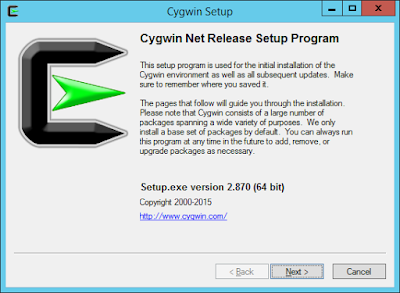
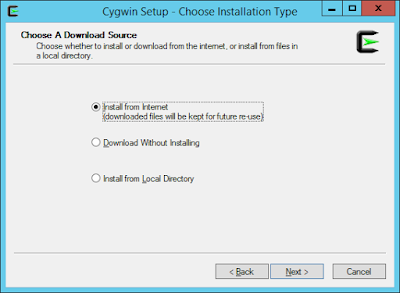
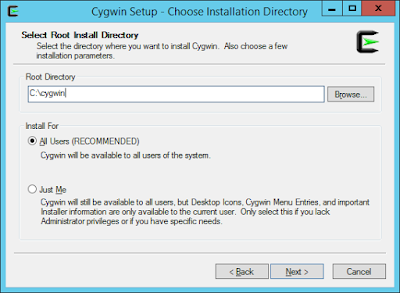
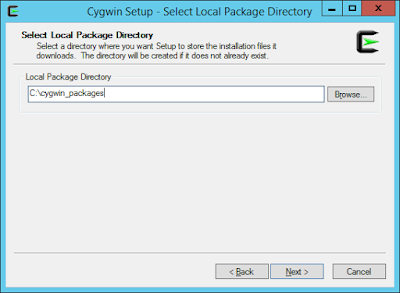
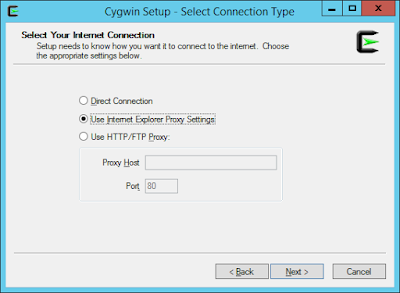
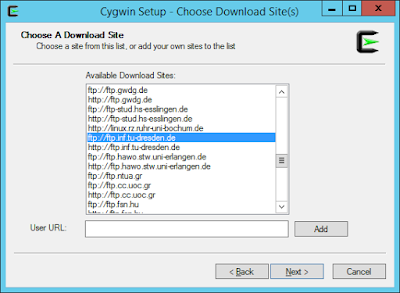


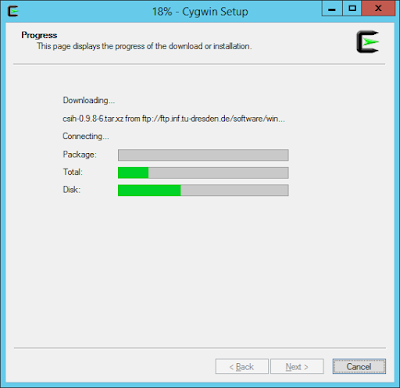
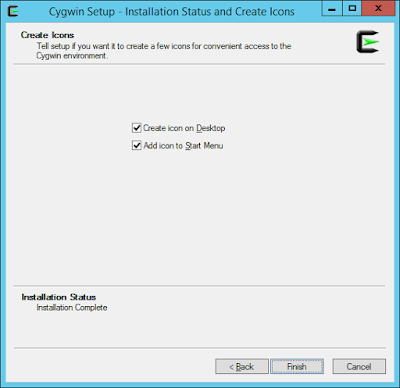
2) CONFIGURATION
2.1) Should we edit cygwin.bat?
You’ll probably find numerous recommendation on the net (and even in Oracle documentation — “Enterprise Manager Cloud Control Basic Installation Guide”) that first thing you should do is to open cygwin.bat and insert line set CYGWIN=binmode ntsec, so that bat would look like:
(Thanks to alesk for his great job)
Whenever I need some Cygwin functionality on my Windows hosts, I always prefer pre-packaged solutions (Mobaxterm for ssh client on Windows, CopSSH for SSHD, etc.). This time around I needed a free SSH server for Windows 2012R2 host without the limits imposed by recent CopSSH free version. I decided that I’ll try to use SSHD from cygwin.com directly, something that I tried to avoid in the last decade.
1) INSTALLATION
First you’ll need to download installer from cygwin.com, save the file in some temporary directory. I downloaded 64-bit version because I’ll be installing 64-bit packages. More precisely, I selected the following packages and their dependencies: nano, zip, unzip, OpenSSH, openssl and rlwrap.
Run the installer and follow the wizard, here are screenshots from my host:










2) CONFIGURATION
2.1) Should we edit cygwin.bat?
You’ll probably find numerous recommendation on the net (and even in Oracle documentation — “Enterprise Manager Cloud Control Basic Installation Guide”) that first thing you should do is to open cygwin.bat and insert line set CYGWIN=binmode ntsec, so that bat would look like:
notepad c:\cygwin\cygwin.bat
|
@echo off |
2.2) Test installation
Open C:\cygwin\cygwin.bat and run:
$ cygrunsrv -h
|
And you should see help for cygwrunsrv, otherwise something went wrong and you’ll likely have to re-install.
2.3 Configure SSHD service by opening cygwin.bat with “Run as Administrator” privilege:
$ ssh-host-config
|
*** Info: Generating missing SSH host keys
|
Note the line 33:
*** Query: Enter the value of CYGWIN for the daemon: [] binmode ntsec
|
Here you should enter any env. variables for cygwin daemon if any. I did NOT set those two variables, they’re here only as a note point. According to cygwin documentation, both parameters are obsolete since Cygwin 1.7, I believe the only reason both parameter are still listed, even in Oracle current documentation, is that someone found some old “how-to” on the net (which was valid before 1.7 release) and took it as granted.
After configuration you should check services, you should see CYGWIN sshd….
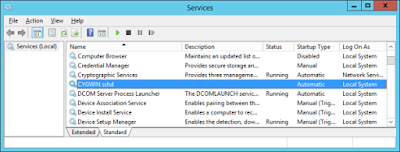
and two new local accounts, cyg_server and sshd…

2.4) Enable existing local user account to connect to SSH daemon
// take a backup if by any chance you already have a passwd file (not the case for fresh installation!) |
Open cygwin.bat:
$ /bin/mkpasswd -l -u alesk >> /etc/passwd
|
The above command will write something like this in the passwd file:
ACMEHOST+alesk:*:197610:197121:U-ACMEHOST\alesk,S-1-5-21-1611771360-925472152-3555864332-1002:/home/alesk:/bin/bash |
It means that you can connect to ACMEHOST from some remote workstation with:
$ ssh ACMEHOST+alesk@ACMEHOST
|
Not cool. I prefer using, simple:
$ ssh alesk@acmehost
so, I changed the username in /etc/passwd to:
alesk:*:197610:197121:U-ACMEHOST\alesk,S-1-5-21-1611771360-925472152-3555864332-1002:/home/alesk:/bin/bash
|
And for a domain account you would execute:
$ /bin/mkpasswd -d -u alesk >> /etc/passwd
|
2.5) Edit ssh config file
notepad C:\cygwin\etc\sshd_config
|
or within cygwin.bat:
nano /etc/sshd_config
|
At the end of file add:
KexAlgorithms diffie-hellman-group-exchange-sha1,diffie-hellman-group1-sha1
|
I’m not sure what is the true reasoning for that, but probably for hardening the sshd security!?
2.6) Start SSH daemon
Cygwin.bat
/usr/bin/sshd
|
or
$ cyrunsrv -S sshd
|
or start Windows service
Open cmd.exe with “Run as admninistrator”:
|
cmd> net stop "CYGWIN sshd"
|
If service doesn’t start check the log at C:\cygwin\var\log\sshd.log.
If you need to add some package afterwards, simply re-run setup.exe installer and check additional packages that you want to install.









0 comentarios:
Post a Comment